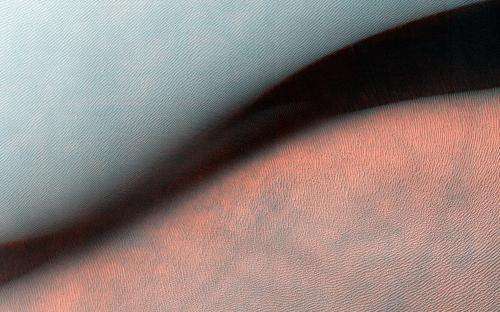NASA image: Giant landform on Mars

(Phys.org) —Sandy landforms formed by the wind, or aeolian bedforms, are classified by the wavelength—or length—between crests. On Mars, we can observe four classes of bedforms (in order of increasing wavelengths): ripples, transverse aeolian ridges (known as TARs), dunes, and what are called "draa." All of these are visible in this Juventae Chasma image.
Ripples are the smallest bedforms (less than 20 meters) and can only be observed in high-resolution images commonly superposed on many surfaces. TARs are slightly larger bedforms (wavelengths approximately 20 to 70 meters), which are often light in tone relative to their surroundings. Dark-toned dunes (wavelengths 100 meters to 1 kilometer) are a common landform and many are active today. What geologists call "draa" is the highest-order bedform with largest wavelengths (greater than 1 kilometer), and is relatively uncommon on Mars.
Here, this giant draa possesses steep faces or slip faces several hundreds of meters tall and has lower-order superposed bedforms, such as ripples and dunes. A bedform this size likely formed over thousands of Mars years, probably longer.
This image was acquired by the HiRISE camera aboard NASA's Mars Reconnaissance Orbiter on Jan. 6, 2014. The University of Arizona, Tucson, operates the HiRISE camera, which was built by Ball Aerospace & Technologies Corp., Boulder, Colo. NASA's Jet Propulsion Laboratory, a division of the California Institute of Technology in Pasadena, manages the Mars Reconnaissance Orbiter Project for the NASA Science Mission Directorate, Washington.
Provided by NASA





















